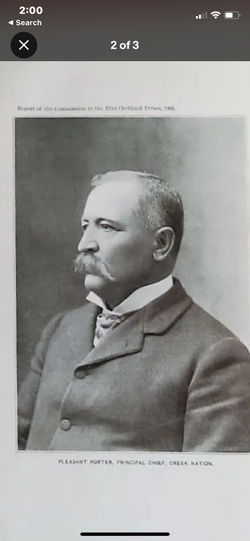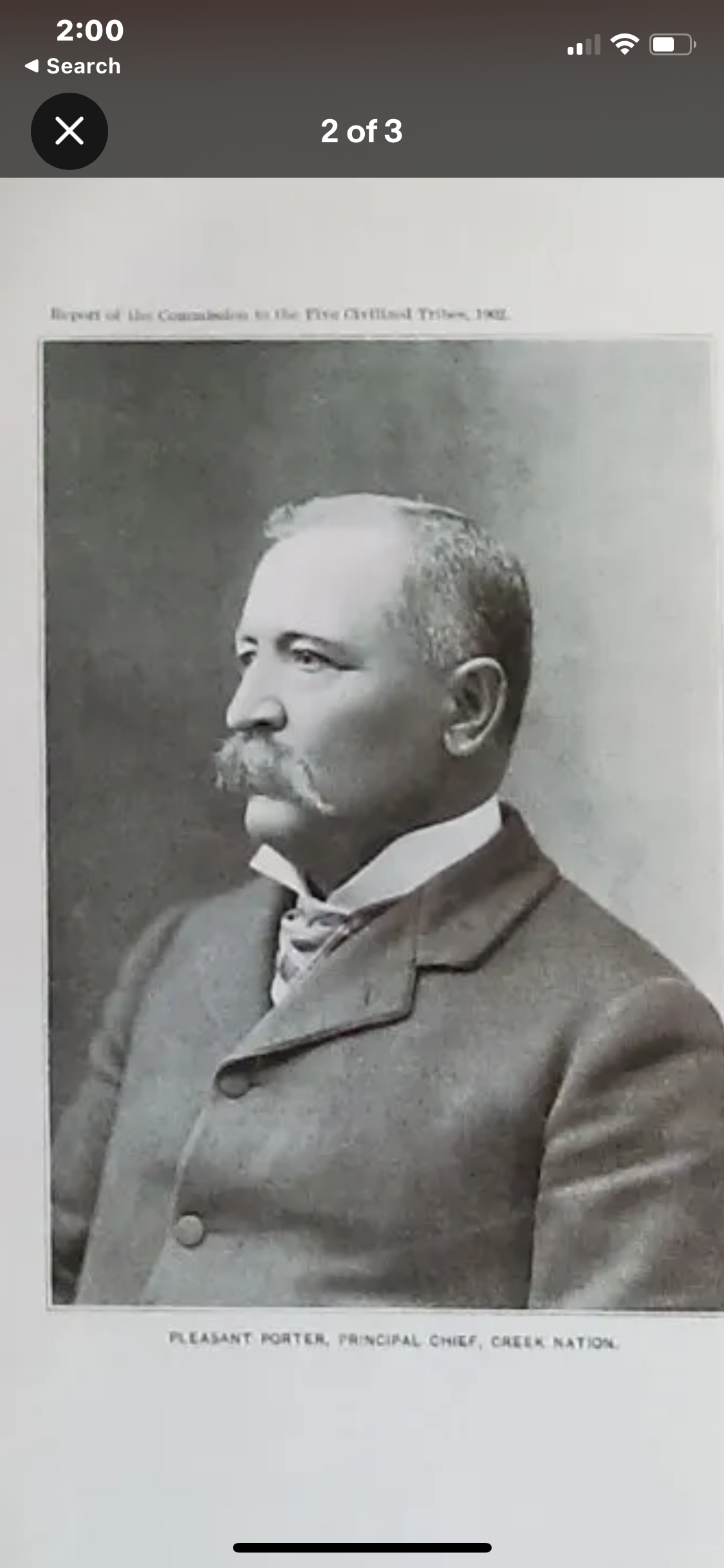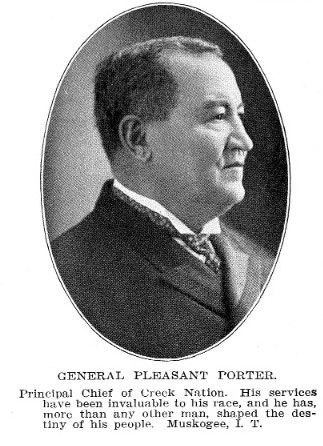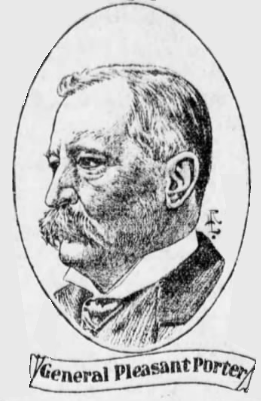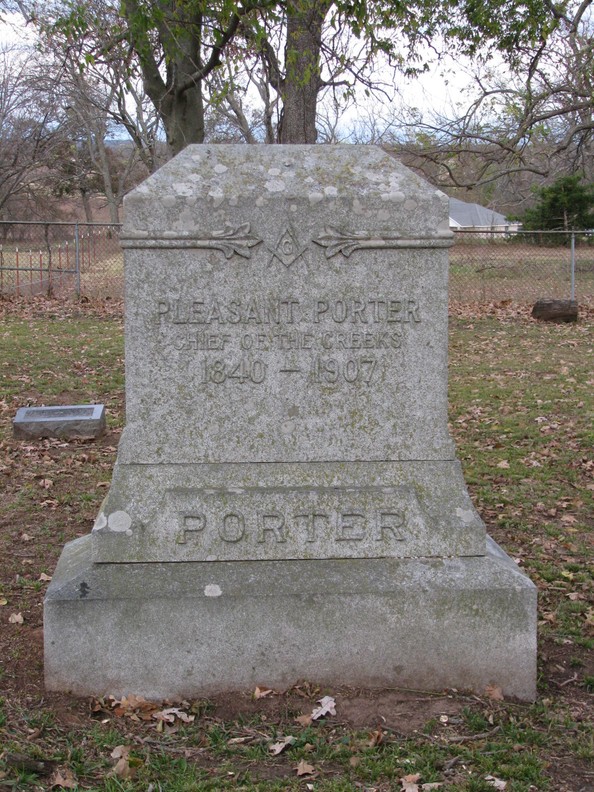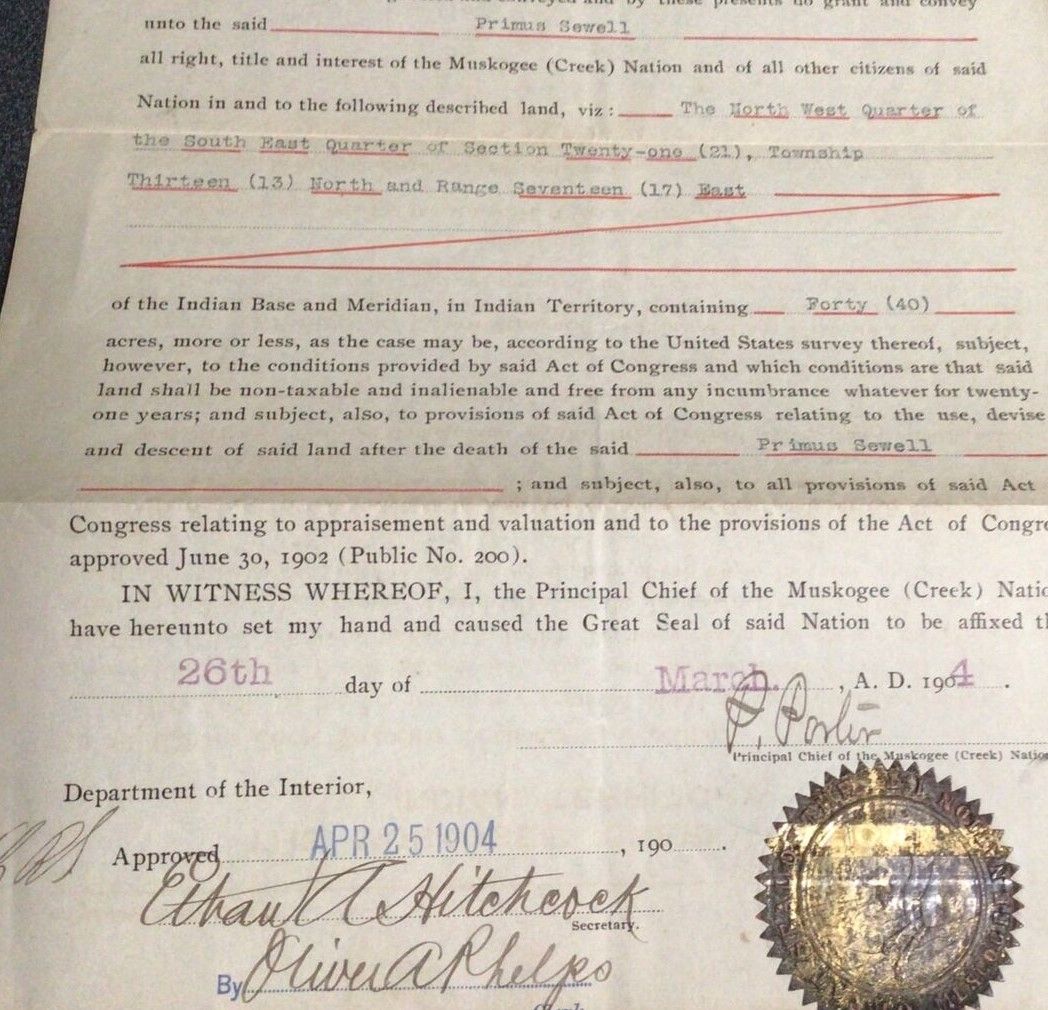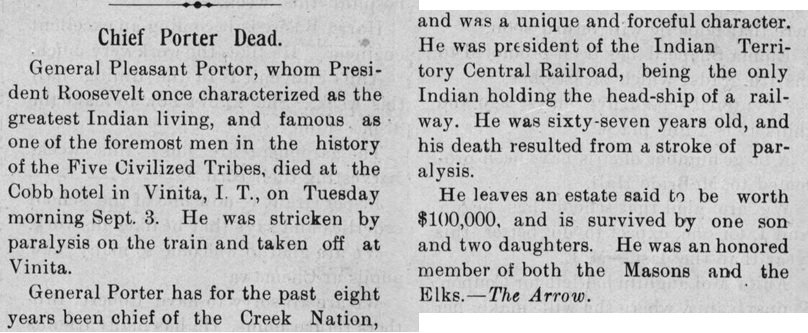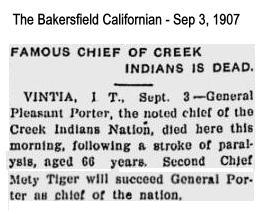04 MAR 2021 SAC with full bio, added below.~Principal Chief of the Creek [Muskogean] Indians.(c 1899). General (US Army) 1872. Civil War Service, 1st LT. 1st Creek Regiment. 1861-1865.
Husb. of Mary Ellen [Keys] Porter (d.1882); parents of Wm. Adair Porter; Pleasant S.; and Annie May Porter.
Marr.(2) Martha L.Bertholf; F/o Leonora Electa Porter. Son of Benjamin & Phoebe [Tustenuk-kee] Porter. Grandson of Chief of the Okmulgees, Tustenaggee, (various spellings.) [Also see biog. data on Wikipedia]
~~~~~~~~~~
Pleasant Porter (September 26, 1840 – September 3, 1907), was a respected American Indian statesman and the Principal Chief of the Creek Nation from 1899 until his death. He served with the Confederacy in the 1st Creek Mounted Volunteers, as Superintendent of Schools in the Creek Nation (1870), as commander of the Creek Light Horsemen (1883), and was many times the Creek delegate to the United States Congress. He was also President of the Sequoyah Constitutional Convention in 1905 during the attempt by Native American tribes to acquire statehood for the Indian Territory.[1] Instead, their territory was made part of the state of Oklahoma.
Early life
Pleasant Porter was the son of Benjamin Edward Porter and Phoebe Perryman, daughter of Lydia Perryman, (a mixed-blood Creek daughter of Chief Perryman), and Tah-lo-pee Tust-a-nuk-kee, a town chief.[2] He was a mix-blood Creek born into his mother's Bird Clan. The Creek had a matrilineal kinship system, in which children took status in their mother's clan.
He was born September 26, 1840 in what is now Wagoner County, Oklahoma. His Creek name was Talof Harjo, which means "Crazy Bear" in English.[3][4]
The family ranch was begun by his grandfather, John Snodgrass Porter, who had fought with Andrew Jackson against the Creek in Georgia after the massacre at Fort Mims. To minimize further bloodshed, Captain Porter volunteered to mediate between the Creek leaders and white army. Grateful for his efforts, the Creek adopted him into the tribe. First, he settled on Creek land in Russell County, Alabama. When the Indian Removal program began, he moved with the first group of Lower Creek who went to Indian Territory in the 1820s. There, he settled on the north bank of the Arkansas River and developed a plantation based on the labor of enslaved African Americans.[4]
As John Porter was dying in 1847, other family members gathered around his deathbed. His grandson Pleasant was seven and had Indian features. According to historian John Meserve, Porter put his hand on the boy's head and announced to the family, "He will do more than any of you."[4]
Pleasant Porter was educated at the Tullahassee Mission School, where he spent five years. His home was bi-cultural, and he learned both Muscogee and English; this gave him the advantage of being able to operate well in both the white and Native American worlds when he became an adult.[3] He supplemented this basic education by developing a lifelong habit of study at home. After leaving school, he clerked in a store for a while. He traveled to New Mexico, where he drove cattle until the outbreak of the Civil War.[4]
Civil War service
During the Civil War, Porter served in the First Confederate Creek Regiment. He had enlisted as a Private under the command of Col. D. N. McIntosh (son of chief William McIntosh, who had been prominent prior to removal and was executed for ceding communal lands). Porter participated in several battles, including Round Mountain, Chusto-Talasah (Bird Creek), Chustenahlah, Pea Ridge and Honey Springs. He was wounded three times. Once wounded in the thigh, he walked with a limp for the rest of his life. Twice he was wounded in the head. His highest rank was Quartermaster Sergeant.[4]
Creek political life
In 1865, Porter served as a guard for Creek commissioners who travelled to Fort Smith, Arkansas to begin peace negotiations with U. S. government representatives. The treaty was concluded and the Creek government reorganized in 1866. Porter was asked to reorganize the Creek Nation's schools, which had been disrupted by the war. In 1871, he was reelected as Superintendent of Schools, but declined this second term.[4]
Tribal insurrections
The "Sands Rebellion" of 1871 was the culmination of grievances between two Creek factions. The name refers to the leader of a disgruntled group of Upper Creeks led by Oktars-sars-har-jo (known in English as "Sands".)[5] When Principal Chief Samuel Checote convened the council in October 1871, nearly 300 Sands followers marched on the capital and dispersed the meeting. Pleasant Porter, commanding a group of Creek horsemen, and a group of Federal agents put down the short-lived rebellion without loss of life. Porter convinced the Sands followers to lay down their arms and go home.[5]
In the fall of 1872, the Creek Nation sent Porter to Washington, D.C. to represent the nation's interests with Congress and the government. He performed this work so effectively that he spent much of the rest of his life on business in the national capital. He soon became well-known and respected by members of Congress and several presidents, becoming a personal friend of Theodore Roosevelt.[4]
In 1875, Lachar Haijo was elected Principal Chief to replace Checote. Checote supporters controlled the Creek legislature and impeached Haijo, replacing him with a Checote supporter. Porter was called on to quell the subsequent demonstration and convinced the Haijo supporters to go home.[4]
In 1882, an Okmulgee judge named Isparhecher was charged with sedition and removed from office by the Creek National Council. He gathered about 350 followers of Sands and Haijo, established a military camp and formed a rival government, complete with armed light horsemen. Checote recalled Porter from Washington and put him in charge of about 700 men. This began what, according to Meserve, the Creeks called the "Green Peach War". Porter's troops chased their opponents into Sac and Fox territory in February 1883. Isperhecher and his remaining followers tried to gain asylum with the Kiowa, but U. S. troops captured them and sent them to Fort Gibson. According to Meserve, there were seven or eight casualties of the Green Peach War. Afterward, some Creek began calling Porter "General" as an honorific title.[4] This was apparently purely honorific.
Isparhecher remained the de facto leader of the full-bloods (then known as the Nuyaka faction). When Checote stepped down as principal chief in 1883, an election elevated a follower of Isparhecher to the position, narrowly defeating Isparhecher himself. Checote came in a distant third. Isparhecher served briefly in December 1883. On February 24, 1884, the Indian Agent at Muskogee, under orders from the Secretary of the Interior, whose department administered Native American affairs, officially recognized Joseph Perryman as the Principal Chief, although he was not elected by the Council.[6]
Under the terms of the Dawes Act, the Creek Nation had to agree to an allotment of former tribal lands to individual households, in an effort to force adaptation to European-American styles of farming and property ownership. Porter headed another Creek commission to negotiate the terms with Federal officials. Agreement was announced September 27, 1897 and incorporated as part of the Curtis Act, passed by Congress in June 1898. The US insisted that any land remaining after allotment would be considered "surplus" and made available for sale to non-Indians. Although the agreement was rejected by the Creek in an election on November 1, 1898, the Dawes Commission began to register tribal members for the process of allotment.[4]
Porter headed a delegation to Washington, C. C. in January 1889 to negotiate the terms for turning over some more of their land to the United States, as required by the 1866 peace treaty. At the time the treaty was signed, it was intended that these lands were to be used for the resettlement of other Native Americans and freedmen. The lands were not intended for settlement by whites. Now, the government wanted to open these so-called "unassigned lands" for white settlement. Porter and his delegation agreed to remove the restrictions on land use in exchange for $2.25 million. The agreement was signed on January 31, 1889.[4]
Pleasant Porter was elected Principal Chief on September 5, 1899. He and his delegation negotiated more concessions regarding rights of individual Creek members than had been allowed to many other tribes. But, many Creek opposed the allotment plan and break-up of communal land. In 1900, a leader of the full-blood faction, Chitto Harjo ("Crazy Snake"), declared a separate government. Porter appealed to the U. S. government for help putting down the revolt. A cavalry troop arrived and arrested the leaders in January 1901. Crazy Snake and his lieutenants pleaded guilty, were lectured by the judge, and sent home.[4]
Porter was reelected as Principal Chief in 1903. The powers of the office had been greatly reduced by the Curtis Act, so its duties were largely ceremonial or clerical. Much time was consumed signing land allotment deeds. Porter and other prominent leaders became interested in the movement to create a state out of Indian Territory, to be governed by Native Americans. The movement proposed to call it the State of Sequoyah, after the Cherokee who created an alphabet.[4]
Porter and the Sequoyah Constitutional Convention
Main article: Sequoyah Constitutional Convention
The Sequoyah Convention met in the Hinton Theater at Muskogee on August 21, 1905. The purposes were to draft a constitution for the proposed state, choose a name for the state, and name a capital city. Porter was elected permanent chairman of the convention. Other key officers elected by the delegates included Charles N. Haskell, vice chair and Alexander Posey, secretary. The delegates met again on the following day, then departed. They reconvened for a three-day meeting in September, at which the proposed constitution was overwhelmingly approved. At a third session on October 14, the delegates voted to authorize Porter and Posey to sign the document on behalf of all the delegates.[7]
Family life
After the Civil War, Porter restored the family plantation. He also went into business as a merchant and rancher.[3] He opened a general store at Okmulgee that he sold in 1869. He moved to Wealaka, built a home and lived there for the rest of his life.[4]
Pleasant Porter married Mary Ellen Keys in St. Louis, Missouri on November 25, 1872. She was born in the Cherokee Nation on April 6, 1854, the daughter of Judge Riley Keys and his wife; he was chief justice of the courts of the Cherokee Nation for twenty-five years. The Porters had three children: William Adair, Pleasant and Annetta Mary. Mary Ellen died at Wealaka on January 15, 1886.[4]
The widower Porter married Mattie Leonora Bertholf, a cousin of his first wife, on May 26, 1886. They had one daughter, Leonora.[4] She died July 19, 1929.[8]
Death
Porter, accompanied by Judge John R. Thomas and M. L. Mott, Creek Nation attorney, boarded a train on September 2, 1907 to attend to legal business in Missouri. They had to stop over in Vinita, I. T. to change trains. Porter complained of feeling unwell, had a stroke sometime that night, lapsed into a coma and died on the morning of September 3, 1907.[4] He is buried in the Pleasant Porter Cemetery in Bixby, Oklahoma.
[Source: "Pleasant Porter", Wikipedia, Mar 2021] [Courtesy of Contributor: B Thomas (48259345)]
04 MAR 2021 SAC with full bio, added below.~Principal Chief of the Creek [Muskogean] Indians.(c 1899). General (US Army) 1872. Civil War Service, 1st LT. 1st Creek Regiment. 1861-1865.
Husb. of Mary Ellen [Keys] Porter (d.1882); parents of Wm. Adair Porter; Pleasant S.; and Annie May Porter.
Marr.(2) Martha L.Bertholf; F/o Leonora Electa Porter. Son of Benjamin & Phoebe [Tustenuk-kee] Porter. Grandson of Chief of the Okmulgees, Tustenaggee, (various spellings.) [Also see biog. data on Wikipedia]
~~~~~~~~~~
Pleasant Porter (September 26, 1840 – September 3, 1907), was a respected American Indian statesman and the Principal Chief of the Creek Nation from 1899 until his death. He served with the Confederacy in the 1st Creek Mounted Volunteers, as Superintendent of Schools in the Creek Nation (1870), as commander of the Creek Light Horsemen (1883), and was many times the Creek delegate to the United States Congress. He was also President of the Sequoyah Constitutional Convention in 1905 during the attempt by Native American tribes to acquire statehood for the Indian Territory.[1] Instead, their territory was made part of the state of Oklahoma.
Early life
Pleasant Porter was the son of Benjamin Edward Porter and Phoebe Perryman, daughter of Lydia Perryman, (a mixed-blood Creek daughter of Chief Perryman), and Tah-lo-pee Tust-a-nuk-kee, a town chief.[2] He was a mix-blood Creek born into his mother's Bird Clan. The Creek had a matrilineal kinship system, in which children took status in their mother's clan.
He was born September 26, 1840 in what is now Wagoner County, Oklahoma. His Creek name was Talof Harjo, which means "Crazy Bear" in English.[3][4]
The family ranch was begun by his grandfather, John Snodgrass Porter, who had fought with Andrew Jackson against the Creek in Georgia after the massacre at Fort Mims. To minimize further bloodshed, Captain Porter volunteered to mediate between the Creek leaders and white army. Grateful for his efforts, the Creek adopted him into the tribe. First, he settled on Creek land in Russell County, Alabama. When the Indian Removal program began, he moved with the first group of Lower Creek who went to Indian Territory in the 1820s. There, he settled on the north bank of the Arkansas River and developed a plantation based on the labor of enslaved African Americans.[4]
As John Porter was dying in 1847, other family members gathered around his deathbed. His grandson Pleasant was seven and had Indian features. According to historian John Meserve, Porter put his hand on the boy's head and announced to the family, "He will do more than any of you."[4]
Pleasant Porter was educated at the Tullahassee Mission School, where he spent five years. His home was bi-cultural, and he learned both Muscogee and English; this gave him the advantage of being able to operate well in both the white and Native American worlds when he became an adult.[3] He supplemented this basic education by developing a lifelong habit of study at home. After leaving school, he clerked in a store for a while. He traveled to New Mexico, where he drove cattle until the outbreak of the Civil War.[4]
Civil War service
During the Civil War, Porter served in the First Confederate Creek Regiment. He had enlisted as a Private under the command of Col. D. N. McIntosh (son of chief William McIntosh, who had been prominent prior to removal and was executed for ceding communal lands). Porter participated in several battles, including Round Mountain, Chusto-Talasah (Bird Creek), Chustenahlah, Pea Ridge and Honey Springs. He was wounded three times. Once wounded in the thigh, he walked with a limp for the rest of his life. Twice he was wounded in the head. His highest rank was Quartermaster Sergeant.[4]
Creek political life
In 1865, Porter served as a guard for Creek commissioners who travelled to Fort Smith, Arkansas to begin peace negotiations with U. S. government representatives. The treaty was concluded and the Creek government reorganized in 1866. Porter was asked to reorganize the Creek Nation's schools, which had been disrupted by the war. In 1871, he was reelected as Superintendent of Schools, but declined this second term.[4]
Tribal insurrections
The "Sands Rebellion" of 1871 was the culmination of grievances between two Creek factions. The name refers to the leader of a disgruntled group of Upper Creeks led by Oktars-sars-har-jo (known in English as "Sands".)[5] When Principal Chief Samuel Checote convened the council in October 1871, nearly 300 Sands followers marched on the capital and dispersed the meeting. Pleasant Porter, commanding a group of Creek horsemen, and a group of Federal agents put down the short-lived rebellion without loss of life. Porter convinced the Sands followers to lay down their arms and go home.[5]
In the fall of 1872, the Creek Nation sent Porter to Washington, D.C. to represent the nation's interests with Congress and the government. He performed this work so effectively that he spent much of the rest of his life on business in the national capital. He soon became well-known and respected by members of Congress and several presidents, becoming a personal friend of Theodore Roosevelt.[4]
In 1875, Lachar Haijo was elected Principal Chief to replace Checote. Checote supporters controlled the Creek legislature and impeached Haijo, replacing him with a Checote supporter. Porter was called on to quell the subsequent demonstration and convinced the Haijo supporters to go home.[4]
In 1882, an Okmulgee judge named Isparhecher was charged with sedition and removed from office by the Creek National Council. He gathered about 350 followers of Sands and Haijo, established a military camp and formed a rival government, complete with armed light horsemen. Checote recalled Porter from Washington and put him in charge of about 700 men. This began what, according to Meserve, the Creeks called the "Green Peach War". Porter's troops chased their opponents into Sac and Fox territory in February 1883. Isperhecher and his remaining followers tried to gain asylum with the Kiowa, but U. S. troops captured them and sent them to Fort Gibson. According to Meserve, there were seven or eight casualties of the Green Peach War. Afterward, some Creek began calling Porter "General" as an honorific title.[4] This was apparently purely honorific.
Isparhecher remained the de facto leader of the full-bloods (then known as the Nuyaka faction). When Checote stepped down as principal chief in 1883, an election elevated a follower of Isparhecher to the position, narrowly defeating Isparhecher himself. Checote came in a distant third. Isparhecher served briefly in December 1883. On February 24, 1884, the Indian Agent at Muskogee, under orders from the Secretary of the Interior, whose department administered Native American affairs, officially recognized Joseph Perryman as the Principal Chief, although he was not elected by the Council.[6]
Under the terms of the Dawes Act, the Creek Nation had to agree to an allotment of former tribal lands to individual households, in an effort to force adaptation to European-American styles of farming and property ownership. Porter headed another Creek commission to negotiate the terms with Federal officials. Agreement was announced September 27, 1897 and incorporated as part of the Curtis Act, passed by Congress in June 1898. The US insisted that any land remaining after allotment would be considered "surplus" and made available for sale to non-Indians. Although the agreement was rejected by the Creek in an election on November 1, 1898, the Dawes Commission began to register tribal members for the process of allotment.[4]
Porter headed a delegation to Washington, C. C. in January 1889 to negotiate the terms for turning over some more of their land to the United States, as required by the 1866 peace treaty. At the time the treaty was signed, it was intended that these lands were to be used for the resettlement of other Native Americans and freedmen. The lands were not intended for settlement by whites. Now, the government wanted to open these so-called "unassigned lands" for white settlement. Porter and his delegation agreed to remove the restrictions on land use in exchange for $2.25 million. The agreement was signed on January 31, 1889.[4]
Pleasant Porter was elected Principal Chief on September 5, 1899. He and his delegation negotiated more concessions regarding rights of individual Creek members than had been allowed to many other tribes. But, many Creek opposed the allotment plan and break-up of communal land. In 1900, a leader of the full-blood faction, Chitto Harjo ("Crazy Snake"), declared a separate government. Porter appealed to the U. S. government for help putting down the revolt. A cavalry troop arrived and arrested the leaders in January 1901. Crazy Snake and his lieutenants pleaded guilty, were lectured by the judge, and sent home.[4]
Porter was reelected as Principal Chief in 1903. The powers of the office had been greatly reduced by the Curtis Act, so its duties were largely ceremonial or clerical. Much time was consumed signing land allotment deeds. Porter and other prominent leaders became interested in the movement to create a state out of Indian Territory, to be governed by Native Americans. The movement proposed to call it the State of Sequoyah, after the Cherokee who created an alphabet.[4]
Porter and the Sequoyah Constitutional Convention
Main article: Sequoyah Constitutional Convention
The Sequoyah Convention met in the Hinton Theater at Muskogee on August 21, 1905. The purposes were to draft a constitution for the proposed state, choose a name for the state, and name a capital city. Porter was elected permanent chairman of the convention. Other key officers elected by the delegates included Charles N. Haskell, vice chair and Alexander Posey, secretary. The delegates met again on the following day, then departed. They reconvened for a three-day meeting in September, at which the proposed constitution was overwhelmingly approved. At a third session on October 14, the delegates voted to authorize Porter and Posey to sign the document on behalf of all the delegates.[7]
Family life
After the Civil War, Porter restored the family plantation. He also went into business as a merchant and rancher.[3] He opened a general store at Okmulgee that he sold in 1869. He moved to Wealaka, built a home and lived there for the rest of his life.[4]
Pleasant Porter married Mary Ellen Keys in St. Louis, Missouri on November 25, 1872. She was born in the Cherokee Nation on April 6, 1854, the daughter of Judge Riley Keys and his wife; he was chief justice of the courts of the Cherokee Nation for twenty-five years. The Porters had three children: William Adair, Pleasant and Annetta Mary. Mary Ellen died at Wealaka on January 15, 1886.[4]
The widower Porter married Mattie Leonora Bertholf, a cousin of his first wife, on May 26, 1886. They had one daughter, Leonora.[4] She died July 19, 1929.[8]
Death
Porter, accompanied by Judge John R. Thomas and M. L. Mott, Creek Nation attorney, boarded a train on September 2, 1907 to attend to legal business in Missouri. They had to stop over in Vinita, I. T. to change trains. Porter complained of feeling unwell, had a stroke sometime that night, lapsed into a coma and died on the morning of September 3, 1907.[4] He is buried in the Pleasant Porter Cemetery in Bixby, Oklahoma.
[Source: "Pleasant Porter", Wikipedia, Mar 2021] [Courtesy of Contributor: B Thomas (48259345)]
Family Members
Sponsored by Ancestry
Advertisement
Explore more
Sponsored by Ancestry
Advertisement
